
The Noctuidae, commonly known as owlet moths, cutworms or armyworms, are the most controversial family in the superfamily Noctuoidea because many of the clades are constantly changing, along with the other families of the Noctuoidea. It was considered the largest family in Lepidoptera for a long time, but after regrouping Lymantriinae, Catocalinae and Calpinae within the family Erebidae, the latter holds this title now. Currently, Noctuidae is the second largest family in Noctuoidea, with about 1,089 genera and 11,772 species. However, this classification is still contingent, as more changes continue to appear between Noctuidae and Erebidae.

Chytolita is a monotypic litter moth genus of the family Erebidae erected by Augustus Radcliffe Grote in 1873. Its only species, Chytolita morbidalis, the morbid owlet moth or morbid owlet, was first described by Achille Guenée in 1854. It is found in large parts of North America, from coast to coast in the north and south to North Carolina, Texas and Florida in the west. The habitat consists of deciduous woods and edges.
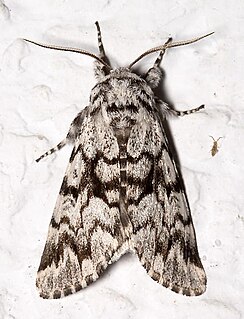
Panthea acronyctoides, the black zigzag or tufted spruce caterpillar, is a moth of the family Noctuidae. The species was first described by Francis Walker in 1861. It is found in North America from Newfoundland to British Columbia and adjacent northern states, south in the west to Colorado, south in the east to New England and Kentucky.

Abagrotis alternata, the greater red dart or mottled gray cutworm, is a moth of the family Noctuidae. The species was first described by Augustus Radcliffe Grote in 1865. It is found in eastern North America, from New Brunswick west across southern Canada to western Alberta, south to Arizona, New Mexico and the Gulf of Mexico.

Catocala junctura, the joined underwing or Stretch's underwing, is an moth in the family Erebidae. The species was first described by Francis Walker in 1858. It is found throughout temperate North America ranging from New York and Pennsylvania west to Montana, Colorado, Oklahoma, Arizona and into Texas, and north to southern Illinois, extreme southern Alberta and Saskatchewan; it has also been recorded west of the Rocky Mountains from California and south-eastern British Columbia. It is typically found near water, where the food plants of its caterpillar larvae grow plentifully.
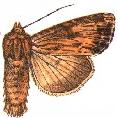
Apamea lignicolora, the wood-coloured Quaker or wood-coloured apamea, is a moth of the family Noctuidae. The species was first described by Achille Guenée in 1852. It is native to North America, where it is distributed across much of Canada and the United States.

Syngrapha microgamma, the little bride looper moth, is a moth of the family Noctuidae. The species was first described by Jacob Hübner in 1823. It is found in much of Canada south in the east to southern Maine, northern New York, and the Great Lakes states. In Europe, it is found from Fennoscandia and central Europe east to mountains eastern Asia.

Panthea gigantea is a moth of the family Noctuidae. It is found throughout much of the warmer and drier regions of western North America from south-central British Columbia, south to the state of Durango in Mexico and from the Black Hills of South Dakota, western Nebraska and the Texas Panhandle west to Washington, Oregon and the coast of California.

Panthea is a genus of the owlet moth family, Noctuidae. The word Panthea is from Greek, meaning "of all gods".
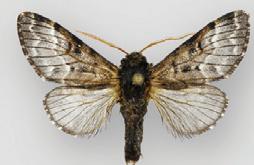
Panthea reducta is a moth of the family Noctuidae. It has been collected at an elevation of 1,800 m (5,900 ft) in a Hispaniolan pine forest in Sierra de Bahoruco National Park in the Dominican Republic.
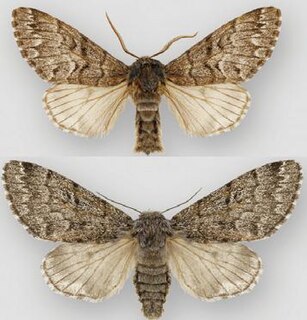
Panthea virginarius, the Cascades panthea, is a moth of the family Noctuidae. It is mainly found west and north of the Great Basin, from the coast of southern California northward to the Queen Charlotte Islands of British Columbia and the Alaskan Panhandle, eastward to central California, northern Nevada, Idaho, north-western Wyoming, western Montana, and south-western Alberta. A disjunct population is found in the Cypress Hills of Alberta and Saskatchewan.
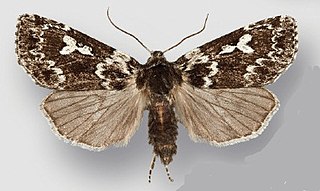
Xestia perquiritata, the boomerang dart, is a moth of the family Noctuidae. The species was first described by Herbert Knowles Morrison in 1874. It is found across North America from Newfoundland, Labrador and northern New England, west to central Yukon, British Columbia and Washington. There are several disjunct populations, including one in the Great Smoky Mountains National Park and the Rocky Mountains in Colorado and a coastal bog in central Oregon.
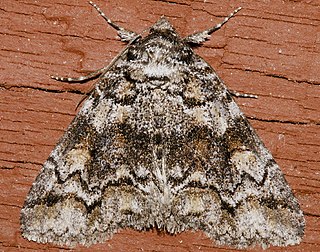
Zale duplicata, the pine false looper zale, pine false looper, banded similar-wing or grey similar-wing, is a moth of the family Noctuidae. The species was first described by Charles J. S. Bethune in 1865. It is found in woodlands and forests from British Columbia to Nova Scotia, south to the mountains of Georgia and Texas.
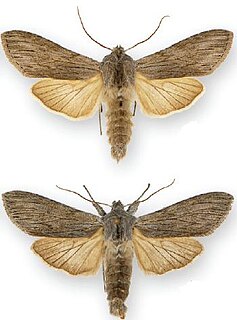
Cucullia intermedia, the dusky hooded owlet, intermediate cucullia, goldenrod cutworm or intermediate hooded owlet, is a moth of the family Noctuidae. The species was first described by Adolph Speyer in 1870. It is found from coast to coast across southern Canada and the northern United States, south in the west to California and to Pennsylvania in the east. In the Rocky Mountains it is found south to the White Mountains in east-central Arizona and occurs commonly in Utah, Colorado and north-eastern Nevada.
Hydraecia intermedia is a moth in the family Noctuidae first described by William Barnes and Foster Hendrickson Benjamin in 1924. It is only known from the holotype, with the type locality of Fort Calgary in south-western Alberta, Canada.

Fishia yosemitae, the dark grey fishia or grey fishia, is a moth in the family Noctuidae. It is found from central Alberta to Colorado in the Rocky Mountain and Great Plains regions. It is also found in eastern, central, and southern California, as well as in the Intermountain region. The habitat consists of dry open areas, including open ponderosa pine forests, juniper woodlands and sagebrush steppe at low to middle elevations.

Chloronycta is a currently monotypic moth genus of the family Noctuidae erected by B. Christian Schmidt and Gary G. Anweiler in 2014. Its only species, Chloronycta tybo, was first described by William Barnes in 1904. It is found in mountainous regions from Mexico to south-eastern Arizona and southwestern New Mexico, north to the Sierra Madre Occidental. The habitat consists of canyons and mid-elevation wooded areas, particularly riparian corridors.
Chaetaglaea fergusoni, or Ferguson's sallow moth, is a moth in the family Noctuidae. It was described by Vernon Antoine Brou Jr. in 1997 and is found in North America.

Lithophane grotei, commonly known as Grote's pinion or Grote's sallow, is a species of moth in the family Noctuidae. It was first described by Riley in 1882 and it is found in North America.
Ponometia virginalis is a species of bird dropping moth in the family Noctuidae. It is found in North America, where it has been recorded from eastern Texas to Nebraska, west to eastern Arizona in the south, and to Utah, Colorado, and Wyoming in the west.















